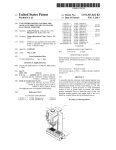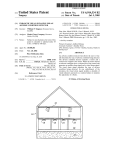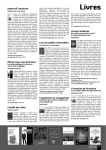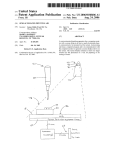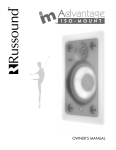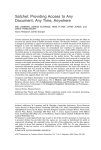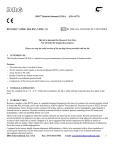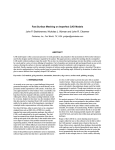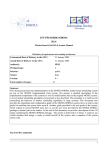Download Manually directed, multi-channel electronic pipetting system
Transcript
US008372356B2 (12) United States Patent Warhurst et a1. (54) MANUALLY DIRECTED, MULTI-CHANNEL ELECTRONIC PIPETTING SYSTEM (75) Inventors: Julian Warhurst, Ashland, MA (US); Gary Nelson, Hollis, NH (US); Richard Cote, Bolton, MA (US) (73) Assignee: Integra Biosciences Corp., Hudson, NH (Us) Notice: (10) Patent N0.: (45) Date of Patent: 6,360,792 6,982,063 7,540,205 7,662,343 7,662,344 8,033,188 2005/0249635 2006/0048846 2007/ 0221684 2009/0074622 3/2002 1/2006 6/2009 2/2010 2/2010 10/2011 11/2005 3/2006 9/2007 3/2009 *Feb. 12, 2013 GanZ et al. Hamel et al. Nelson et al. Mathus et al. Mathus et al. Kalmakis et al. Okun et al. Roenneburg et al. Steinbrenner et a1. Kalamakis et al. (Continued) Subject to any disclaimer, the term of this patent is extended or adjusted under 35 U.S.C. 154(b) by 0 days. B1 B2 B2 B2 B2 B2 A1 A1 A1 A1 US 8,372,356 B2 FOREIGN PATENT DOCUMENTS WO This patent is subject to a terminal dis claimer. 2009/130318 10/2009 OTHER PUBLICATIONS Rainin Pipetting 360° Simultaneous 96-Well pipetting, Fast manual (21) Appl. N0.: 13/099,782 benchtop system, 2009 Rainin Instrument, LLc, PB-210 LIQ RevB, 2 pgs. (22) Filed: May 3, 2011 (Continued) (65) Prior Publication Data US 2011/0268627 A1 Nov. 3, 2011 Related US. Application Data Primary Examiner * Brian R Gordon (74) Attorney, Agent, or Firm *Andrus, Sceales, Starke & SaWall, LLP (60) Provisional application No. 61/330,541, ?led on May 3, 2010. (51) (57) Int. Cl. A manually directed, multi-channel electronic pipetting sys B01L 3/02 (52) (2006.01) tem is designed to transfer liquids from a standard multi-Well US. Cl. ...... .. 422/509; 422/511; 422/516; 422/522; 422/524; 422/525; 73/863.32; 73/864; 73/864.01; (58) ABSTRACT plate, deep-Well plate or reservoir into another multi-Well plate. The preferred pipetting head includes an array of 96-tip 73/864.11; 73/864.24; 73/864.25 ?ttings. A deck With at least one but preferably tWo or more Field of Classi?cation Search ................ .. 422/ 509, Wellplate nesting receptacles holds one or more multi-Well plates or reagent reservoirs for access by an array of dispos 422/511, 516, 5194522, 5244525, 63468.7; 73/863.32, 864, 864.01, 864.11, 864.13, 73/864.16*864.21, 864.25, 864.31 See application ?le for complete search history. (56) able pipette tips mounted to the pipetting head. The electronic motion control system includes a control handle that is mounted to a load cell, the carriage for the pipetting head and is held in the palm of the user. In use, the user grasps the control handle and operates the system in a manner similar to one using a handheld electronic pipettor. References Cited U.S. PATENT DOCUMENTS 4,478,094 A * 5,116,180 A 10/1984 Salomaa et al. 5/1992 Fung et al. ......... .. 73/863.32 23 Claims, 14 Drawing Sheets US 8,372,356 B2 Page 2 US. PATENT DOCUMENTS 2009/0274587 A1 2011/0209564 A1 * 11/2009 ButZ et al. 9/2011 Von Beichmann et al. 2011/0268628 A1 2011/0296931 A1 ........................ .. 73/86401 11/2011 Warhurst 12/2011 Warhurst OTHER PUBLICATIONS CyBiiWeH Pipettor User Manual, Release Sep. 2008, 88 pgs. Thermo Scienti?c Matrix Hydra II, Product Speci?cation, 2008 Thermo Fisher Scienti?c, Inc., 2 pgs. Thermo Scienti?c Matrix PlateMate 2x3, Product Speci?cation, 2007 Thermo Fisher Scienti?c, Inc., 2 pgs. Thermo Scienti?c Matrix PlateMate Plus, Product Speci?cation, 2007 Thermo Fisher Scienti?c, Inc., 2 pgs. Rainin Pipetting 360° Liquidator 96, Manual benchtop pipetting system, 2008 Rainin Instrument, LLC, 9920-360 Rev. B, 16 pgs. * cited by examiner US. Patent Feb. 12, 2013 Sheet 1 0f 14 US 8,372,356 B2 US. Patent Feb. 12, 2013 30 24 Sheet 2 0f 14 US 8,372,356 B2 US. Patent Feb. 12, 2013 Sheet 3 0f 14 US 8,372,356 B2 30 12 liiiiiiiiiiiiiil iii i i i i i K14 HHHHHHHH iiiiiiiiii'li'iiii' ii ij ij ij ij ij ijij 32 US. Patent Feb. 12, 2013 Sheet 4 0f 14 US 8,372,356 B2 US. Patent Feb. 12, 2013 Sheet 5 0f 14 US 8,372,356 B2 US. Patent Feb. 12, 2013 Sheet 7 0f 14 US 8,372,356 B2 US. Patent Feb. 12, 2013 Sheet 8 0f 14 US 8,372,356 B2 m2 wm US. Patent Feb. 12, 2013 Sheet 9 0114 US 8,372,356 B2 124 O 102 100 124 12298112114 108 100 91 12412 120 108 98 102 US. Patent Feb. 12, 2013 Sheet 10 0f 14 US 8,372,356 B2 30 22 _/1 |6 2/ Q 04 6 ._ l /\.Vv/;=z :L r__, ,__L ,__, ,/8 77 O0416 (O_n :LK 2:.\I 1 \IO 2 _n;l"7 \ US. Patent Feb. 12, 2013 Sheet 11 0114 FIG. 12 _ _ _ _ _ _ _ _ _ 1 US 8,372,356 B2 US. Patent Feb. 12, 2013 Sheet 12 0f 14 24 FIG. 13 US 8,372,356 B2 US. Patent Feb. 12, 2013 Sheet 14 0f 14 US 8,372,356 B2 [-210 218 FIG. 15 US 8,372,356 B2 1 2 MANUALLY DIRECTED, MULTI-CHANNEL mated liquid handling systems can also be con?gured to do ELECTRONIC PIPETTING SYSTEM quite complex pipetting operations, such as mixing, repeat pipetting, diluting, etc. While programmable, automated liquid handling systems FIELD OF THE INVENTION have many desirable features over a fully manual 96-Well liquid transfer system, they are generally too large and expen sive for use in certain laboratory applications. Therefore, in many applications, laboratory technicians are resigned to using multi-channel hand-held pipettors, Which may be quite The invention relates to a manually directed, multi-channel electronic pipetting system Which includes a multi-channel pipetting head having a plurality of pipetting channels arranged in an array or roWs and columns. time-consuming. BACKGROUND OF THE INVENTION SUMMARY OF THE INVENTION Multi-Well plates, also knoWn as microtiter plates or microWell plates, are standard products in clinical and research laboratories. A multi-Well plate is a ?at plate With The invention is a manually directed, multi-channel elec tronic pipetting system for transferring ?uids from a standard multi-Well plate, a deep-Well plate, a rack of sample tubes or a reservoir into another multi-Well plate. The term Wellplate as used herein refers to both standard Well-plates and deep multiple Wells used as individual test tubes. The most com mon multi-Well plates include 96-Wells or 384-Wells arranged in a rectangular matrix. ANSI has set standardiZed dimen Well-plates. sions and SBS footprints for Well-plates. For example, a 96-Well plate has 8 roWs and 12 columns of Wells centered 9 20 millimeters centerline-to-centerline. A typical 384-Well plate includes 16 roWs and 24 columns of Wells With a centerline to-centerline distance of 4.5 millimeters. Multi-Well plates With 1536 Wells and higher are also available. Some multi Well plates are designed to hold larger volumes than a stan dard multi-channel plate yet maintain the standard centerline 25 to-centerline dimensions. These Well-plates are taller and are commonly called deep Well-plates. In the laboratory, multi-Well plates are ?lled With various liquid samples, and it is routine to transfer liquid samples An electronic multi-channel pipetting system constructed in accordance With the invention includes a multi-channel pipetting head in Which the channels are arranged in a tWo dimensional array of roWs and columns. In the exemplary 30 embodiment, the pipetting head includes an array of 96-tip ?ttings corresponding to an array of 96-channels. A pipetting motor is contained Within a carriage for the pipetting head, and drives the pipetting head to aspirate and dispense. Dis posable pipette tips are mounted onto the array of tip ?ttings in order to transfer liquid samples or reagents from one multi Well plate or reservoir to another multi-Well plate. Alterna tively, the pipette tips can be mounted using a magaZine. from one multi-Well plate to another in order to implement assays or store duplicate samples. It is also routine to transfer Wells in a Wellplate and transfer aliquots into another set of The system includes a deck With at least one, but preferably tWo or more Wellplate nesting receptacles for holding a multi Well plate or a reagent reservoir. The system also includes a control handle. Preferably, the control handle is mounted to the carriage for the pipetting head, and resembles a handle for a hand-held electronic pipettor. The preferred control handle Wells on the same Wellplate or another Wellplate. In order to is the same or quite similar to that disclosed in US. Pat. No. liquid reagents or samples from a common reservoir to either a standard multi-Well plate or a deep Well-plate. In some cases, hand-held, multi-channel pipettes, for example 8 or 12 35 channels, are used to draW some or all the liquid from a set of produce a high volume of prepared multi-Well plates, auto mated liquid handling machines have been developed to pro 40 vide much higher throughput than a technician, even With a multi-channel pipettor. In the art, there are several types of automated liquid handling machines to automatically ?ll multi-Well plates. Such automated liquid handling machines typically use sophisticated Cartesian robots for positioning syringes and/or pipette tips, as Well as shuttling Well-plates from storage and into position for liquid transfer. Most of Richard Cote, ?led on Sep. 17, 2007, assigned to the assignee of the present application and incorporated herein by refer ence. The control handle is preferably mounted to a load cell 45 that is attached to a carriage for the pipetting head. The load 50 cell detects force exerted on the control handle When a user exerts pres sure on the handle and outputs a corresponding signal to an electronic motor control system. In use, the user grasps the control handle in a manner similar as When using a hand-held electronic pipettor, and exerts pressure on the con these automated liquid handling machines are rather expen sive, and also quite large. Many include sophisticated com puter control Which requires extensive training, as Well as setup and programming. trol handle to move the pipetting head With respect to the Well-plates or reservoirs on the deck. The load cell preferably includes a plurality of strain gauges to detect the direction and Such automated high-throughput systems are not practical for some applications. In order to address this need, the prior art also includes a simultaneous 96-Well manual pipetting system sold under the trade name Liquidator 96. This fully manual system includes an array of pipette tip ?ttings match ing the dimensions of a standard 96-Well plate. Disposable pipette tips are mounted to the 96-?ttings. The system aspi rates and dispenses liquid from the 96-pipette tips simulta neously. Because the system is fully manual, it lacks the ability to program precise protocols and liquid transfer amount of force that the user exerts on the control handle. The 55 control system moves the multi-channel pipetting head With respect to the deck, accordingly, so that the user can align the pipette tips With the appropriate Wellplate or reservoir on the deck. 60 is mounted to a toWer that contains a motorized, vertical drive In the exemplary embodiment of the invention, the carriage mechanism for raising and loWering the pipetting head With respect to the Wellplate deck. A motoriZed, horizontal drive mechanism moves the toWer and the pipetting head laterally amounts. For example, an electronic hand-held pipettor, or an automated liquid handling system, can be programmed to aspirate a precise volume of liquid reagent or sample and then dispense the aspirated volume, sometimes as a series of 7,540,205 issued Jun. 2, 2009, entitled “Electronic Pipettor”, application Ser. No. 11/856,231 by Gary E. Nelson, George P. Kalmakis, Kenneth Steiner, Joel Novak, Jonathon Finger, and 65 in response to the sensed lateral force exerted on the control handle. For example, if the user presses on the control handle equal-volume aliquots in successive dispensing operations. from left to right, the toWer along With the pipetting head Programmable electronic hand-held pipettors as Well as auto moves from left to right. If the user pulls upWard on the US 8,372,356 B2 3 4 control handle, or pushes downward on the control handle, the vertical drive mechanism raises or loWers the pipetting head accordingly. The speed of the tWo-dimensional move ment of the pipetting head (i.e., x-axis and z-axis) is con stripping plate to eject the disposable pipette tips from the tip ?ttings. The use of the stepped stripping plate enables groups of tips to be sequentially removed from the tip ?ttings, thereby reducing the instantaneous torque load on the motor. In a preferred embodiment, menu-driven softWare displayed trolled by the electronic motion control system. Preferably, the speed is normally in proportion to the amount of force detected by the load cell, hoWever, the electronic motion control system decelerates the pipetting head as it approaches on a user interface on the control handle provides an ejection con?rmation inquiry after the ejector button is activated but prior to transmitting the control signal to strip the pipette tips. mechanical displacement limits. As an alternative to moving the toWer and the pipetting head laterally in response to the detected force exerted on the control handle, it is possible In another embodiment of the invention, the system is designed to hold only one multi-Well plate or reservoir on the deck. In this embodiment, the system does not require a Within the spirit of the invention to maintain the toWer in a ?xed lateral position and move the deck laterally to the left or right in response to the user’s use of the control handle. horizontal drive mechanism, and the pipetting head does not move laterally With respect to the deck. The vertical drive mechanism, hoWever, moves the pipetting head vertically As mentioned, the control handle is preferably similar to that disclosed in the above-incorporated US. Pat. No. 7,540, 205 entitled “Electronic Pipettor”. The control handle there fore preferably includes an elongated body adapted to be held in the hand of the user. On its front side, it has a touch Wheel control that is operated by the user, as Well as a dot matrix user upWard and doWnWard in response to upWard and doWnWard pressure exerted on the control handle. In this embodiment, the user needs to place and remove individual multi-Well plates and/reservoirs from the receptacle nests on the deck. In 20 interface display, Which is located above the touch Wheel control. The preferred system also includes several micropro cessors. In an exemplary embodiment of the invention, one of the microprocessors is located Within the control handle, although locating a microprocessor in the control handle is 25 another similar embodiment, the lateral position of the deck With respect to the pipetting head can be moved manually. In yet another embodiment, the pipetting head is able to move laterally in a direction perpendicular to the X-direction, for example by including a Y-axis drive mechanism Which is responsive to the control handle. In this embodiment of the not necessary to carry out the invention. The preferred system invention, it is preferred that the carriage for the pipetting includes menu-driven softWare for controlling the informa head be mounted to a gantry rather than to a toWer. One of the tion displayed on the user interface display and for program ming the one or more microprocessors that operate the sys tem. A circular touch pad in the touch Wheel control translates rotational movement of the user’s thumb or ?nger into cursor movements on the display in order to navigate the menu advantages of this embodiment of the invention is that alloWs access to tWo roWs of Well-plates on the deck. Another advan 30 pipette tips in the Y-axis direction, Which is helpful When dispensing into 384-Well plates. driven softWare. The menu-driven softWare is, in many respects, similar to the softWare disclosed in application entitled “Pipettor SoftWare Interface”, application Ser. No. tage is that it alloWs motorized, accurate positioning of the 35 11/856,232 by Gary Nelson, George P. Kalmakis, Gregory Mathus, Joel Novak, Kenneth Steiner and Jonathon Finger, If desired, the X-axis lateral drive, or the combination of the X-axis and Y-axis horizontal drives can be replaced by a rotational axis horizontal, and perhaps With a radial extender drive. In still another embodiment, relative vertical and horizon ?led Sep. 17, 2007, now US. Pat. No. 8,033,188, issued Oct. tal, or vertical only, motion betWeen the carriage and pipetting 11, 2011, assigned to the assignee of the present application and incorporated herein by reference. For example, the soft Ware provides graphic displays for adjusting volume, relative pipetting speed, pace and count for the various programmed pipetting procedures. The softWare also preferably provides multiple programmable pipetting modes based on predeter mined algorithms such as pipette, repeat pipette, sample dilute, pipette/mix, manual pipette, reverse pipette, variable dispense, variable aspirate, sample dilute/mix, and serial dilu head on the one hand and the deck on the other hand is 40 implemented in a manual fashion. In this embodiment, the pipetting is still implemented in an electronic fashion, and is preferably controlled by using a user interface on a control handle. Other advantages and modi?cations to the invention may be apparent to those of ordinary skill in the art upon 45 revieWing the folloWing draWings and description thereof. BRIEF DESCRIPTION OF THE DRAWINGS tion. These functional modes are based on predetermined algorithms embedded in the softWare to implement respec tive, Well knoWn pipetting procedures, although various 50 parameters such as volume, speed, pace, count, direction, and mixing are available for programming and editing for the FIG. 2 is a front elevational vieW of the multi-channel pipetting system illustrated in FIG. 1. user. In addition, the preferred softWare includes a custom programming mode in Which the user can create custom pipetting procedures based on the steps of aspirating, mixing, dispensing and purging. The preferred softWare also includes 55 Another aspect of the invention is directed to the tip ej ec tion mechanism. Preferably, an ejector button is located on 60 channel, hand-held pipettor. A sensor on the control handle detects that the ejector button has been activated and relays a signal to an electronic control system to activate an automated tip stripping mechanism on the multi-Well pipetting head. Preferably, the same motor responsible for moving the pis tons on the pipetting head to aspirate and dispense is driven into an over-extended condition in order to move a stepped FIG. 3 is a side elevational vieW of the manually directed, multi-channel electronic pipetting system illustrated in FIGS. 1 and 2. FIG. 4 is a vieW similar to FIG. 1 illustrating tip attachment. FIG. 5 is a vieW of the control handle and its attachment to other features as Well. the control handle similar as in a single-channel or multi FIG. 1 is a perspective vieW of a manually directed, multi channel electronic pipetting system constructed in accor dance With an exemplary embodiment of the invention. a load cell and carriage in manually directed, multi-channel electronic pipetting system shoWn in FIGS. 1-4. FIG. 6 is a loWer perspective vieW of the pipetting head and pipetting motor a vieW of the manually directed, multi-chan nel electronic pipetting system shoWn in FIGS. 1-5. FIG. 7 is a rear loWer perspective vieW illustrating internal 65 components of the manually directed electronic multi-chan nel pipetting system illustrated in FIGS. 1-6. FIG. 8 is a vieW taken along line 8-8 in FIG. 7. US 8,372,356 B2 5 6 FIG. 9 is a sectional view taken along line 9-9 in FIG. 7. FIG. 9 illustrates the tower being in the left hand side recep head because of alignment and weight issues. It would be extremely dif?cult to properly align all 96-pipette tips with a detached handheld pipettor. Both linear alignment and angu lar alignment errors would make such a system impractical. Moreover, such a system would be relatively heavy, perhaps tacle position. FIG. 10 is a view similar to FIG. 9 illustrating the tower in the right hand side receptacle position. 5-10 lbs., which is also impractical. The manually directed, FIG. 11 is a side elevational view schematically illustrating the Z-axis vertical drive mechanism in the tower. FIG. 12 is a detailed view taken along line 12-12 in FIG. 11. FIG. 13 is a detailed view taken along line 13-13 in FIG. 12. FIG. 14 is a block diagram illustrating electromechanical and software control loop used in accordance with one embodiment of the invention. FIG. 15 illustrates another embodiment of the invention in multi-channel electronic pipetting system 10 illustrated in FIGS. 1-14, provides reliable mechanical alignment of the pipette tips 14, and also isolates the user from the actual weight of the pipettor. The carriage 22 and tower 24 mechanically support the pipetting head 12 and allow movement of the pipetting head 12 along the vertical Z-axis and the horiZontal X-axis, but prevent unwanted Y-axis motion or rotation. Other mechani cal arrangements could be used in accordance with the inven tion to support and move the pipetting head in a similar fashion, such as a gantry system, although the tower 24 and which the manually directed, multi-channel electronic pipet ting system is designed to hold only one multi-well plate or reservoir on the deck. carriage 22 mechanism have been found to be practical. DETAILED DESCRIPTION OF THE DRAWINGS The manually directed, multi-channel electronic pipetting A ?rst embodiment of a manually directed, multi-channel electronic pipetting system 10 constructed in accordance with the invention is illustrated in FIGS. 1-14. Referring to FIGS. 20 1 -3, the manually directed, multi-channel electronic pipetting system 10 includes a multi-channel pipetting head 12 having a plurality of pipetting channels arranged in a two dimen sional array of rows and columns. Normally the pipetting head 12 will include an array of 96-tip ?ttings. An array of pipette tips 14 are attached to the multi-channel pipetting head 12. The manually directed, multi-channel electronic pipetting system 10 includes a ?at deck 16 supporting a right nesting receptacle 18 and a left nesting receptacle 20. The tips. FIG. 4 illustrates a box 34 of pipette tips located on the 25 magaZine. The preferred tip attachment and ejection mecha 30 35 The pipetting head 12 is removably mounted to a carriage the tower 24 and the deck 16. An X-axis drive mechanism moves the tower 24 and the carriage 22 horizontally along an X-axis so that the pipetting head 12 and the array of tips 14 can be moved from a position corresponding to the wellplate 26 in the ?rst nesting receptacle 18 on the deck 16 to positions application and incorporated herein by reference. Brie?y, the 40 45 corresponding to the wellplate 28 residing in the left side nesting receptacle 20. The system 10 includes a control handle 30 preferably mounted to the carriage 22 and as mentioned previously and preferably resembles a handle for a handheld electronic pipet tor. More speci?cally, the control handle 30 is preferably mounted to a load cell 32 that is attached to the carriage 22. In use, the user grasps the control handle 30 in the manner similar as when using a handheld pipettor, and exerts pres sure on the control handle 30 to move the carriage 22 and the 55 quite di?icult; however, motion control software facilitates Electromechanical and software controls motion of the 60 ment, and control force exerted by the drive systems, etc. General aspects of the motion control system are described below in connection with FIG. 14. Preferably, biasing soft ware as disclosed in patent application “Pipette Tip Position ing for Manually-Directed, Multi-Channel Electronic Pipet overall operation of the system 10 is intended to replicate the user would not be able to reliably use a 96-channel pipetting motion of the carriage 22 and pipetting head 12 is controlled by the user by holding the controller 30 in their palm and applying pressure in the appropriate direction to position the pipetting head 12 over the tray 34 of pipette tips 14. Precise alignment necessary for tip attachment would of course be pipetting head and smooth operation, foster precise align discussed in more detail below. As mentioned, the use of the controller 30 as well as the pipettor. However, with a conventional handheld pipettor, a driven mechanism. Then, the Z-axis vertical drive mechanism is used to lower the carriage 22 and the tip ?ttings 36 with suf?cient force to attach the array of pipette tips 14. The carriage 22 and the pipetting head 12 are then raised using the Z-axis horiZontal vertical drive mechanism to remove the tips 14 from the tip container 34. The tip container 34 is removed from the nested receptacle 18 and replaced with a wellplate or reservoir in order to transfer ?uids. For tip attachment as with precise alignment. servo control as is explained below. The control handle 30 natural hand motion of a user using a conventional handheld pipetting head 12 with the array of tip ?ttings 36 is aligned precisely over the tip container 34 using the X-axis horiZontal regular motion control, the general horiZontal and vertical 50 pipetting head 12. The vertical Z-axis motion and the hori Zontal X-axis motion are driven by independent motors under also preferably includes a user interface for controlling pipet ting functions such as aspirating and dispensing as is also nism is disclosed in detail in patent application entitled “Unintended Motion Control for Manually Directed Multi Well Electronic Pipettor” ?led on even date herewith by Julian Warhurst and Richard Cote, claiming priority to US. Provisional Patent Application No. 61/330,545, ?led on May 3, 2010, now US. patent application Ser. No. 13/099,953, ?led May 3, 2011, Publication No. US 2011/0268628, pub lished Nov. 3, 2011, assigned to the assignee of the present 22 which in turn is mounted to a tower 24. A pipetting motor located within the carriage 22 drives the multi-channel pipet ting head 12 to aspirate and dispense. As described in more detail below, a Z-axis drive mechanism moves the carriage 22 and the multi-channel pipetting 12 vertically with respect to right side nesting receptacle 18 ready for attachment to the pipetting head 12. The preferred pipetting head includes an array of 96-tip ?ttings, see eg reference number 36 in FIG. 6. However, other ways known in the art to mount tips can be used in accordance with the invention, such as using the nesting receptacles 18, 20 are designed to hold multi-well plates, racks of storage tubes or reservoirs in a known location on the deck 16. The nesting receptacles 18, 20 can be attached to the deck 16 or can be made integral with the deck 16. system 10 must not only be capable of transferring ?uids from and to selected locations, but must also provide for the prac tical and convenient attachment and ejection of the pipette 65 tor”, by Julian Warhurst, ?led on even date herewith, claiming priority to US. Provisional Patent Application No. 61/330, 551, ?led on May 3, 2010, now US. patent application Ser. No. 13/099,854, ?led May 3, 201 1, Publication No. US 2011/ US 8,372,356 B2 7 8 0296931, published Dec. 8, 2011, and assigned to the assignee of the present application and incorporated herein by reference is used to facilitate appropriate horizontal align ment of the pipetting head 12 for tip attachment. In addition, including an additional main microprocessor. The circular touchpad 52 translates rotational movement of the user’s thumb (or ?nger) into cursor movements on the display 54 in order to navigate menu driven softWare. The menu driven the system 10 also preferably includes softWare checks to assure proper alignment of the pipetting head before imple menting tip attachment functions, as disclosed in the above closed in application entitled “Pipettor SoftWare Interface”, application Ser. No. 11/856,232 by George Kalmakis et al., softWare is, in many respects, similar to the softWare dis incorporated patent application entitled “Unintended Motion ?led Sep. 17, 2007, noW U.S. Pat. No. 8,033,188 issued Oct. Control for Manually Directed Multi-Channel Electronic Pipettor”. Brie?y, the amount of doWnWard force necessary for tip attachment is substantially greater than the amount of 11, 2011, assigned to the assignee of the present application and incorporated herein by reference. As mentioned previ doWnWard force desirable during normal operation. AlloWing volume, relative pipetting speed, pace and count for the vari ous program pipetting procedures. The softWare also prefer ously, the softWare provides graphic displays for adjusting pipette tips to crash into Well-plates With too much force can cause damage, as Well as loss of reagents and samples and the like. The system 10 preferably includes a tip attach button 38 on top of the carriage 22 Which must be depressed in order for the system 10 to exert suf?cient doWnWard vertical force for tip attachment. For example, the user Will depress a button 38 With their left hand and hold the controller 30 in their right hand and push doWn on the controller 30 in order to move the ably provides multiple programmable pipetting modes based on predetermined algorithms, such as pipette, repeat pipette, sample dilute, pipette/mix, manual pipette, reverse pipette, variable dispense, variable aspirate, sample dilute/mix, and serial dilution. These functional modes are based upon pre determined algorithms embedded in the softWare to imple 20 carriage 22 doWnWard to attach the tips to the pipetting head 12. The tip attachment button 38 need not be located on the top of the carriage 22, although it is desirable to occupy both hands of the user for safety purposes. For example, it may be desirable to place the tip attachment button 38 at a different location on the system 10, or on the surface of the laboratory Workbench. ment respective, Well knoWn pipetting procedures, although various parameters such as volume, speed, pace, count, direc tion and mixing are available for programming and editing for the user. In addition, the preferred softWare also includes a custom programming mode in Which the user can create 25 custom pipetting procedures based on the steps of aspirating, mixing, dispensing and purging. The preferred softWare also includes other features as Well. After samples and/or reagents have been pipetted, the tips While the touch Wheel control 52 and the display 54 are are typically ejected into a tip tray 34 or loosely into a bin. Referring noW to FIG. 5, the control handle 30 is attached to generally used to program the pipetting system, the display 54 30 a cantilever 40 on the load cell 32. The cantilever 40 extends generally horizontally forward from a base 42 of the load cell 32 that is attached to the frame of the carriage 22. A pair of strain gauges 44 is attached to a top surface of the load cell base 42. This pair 44 of strain gauges is used to detect the amount of force or pressure applied by the control handle 30 on the load cell 32 in the X-axis horiZontal direction. Another pair of strain gauges 46 is attached to a sideWall of the base 42 of the load cell 32. This pair of strain gauges 46 is used to detect the amount of force or pressure that the control handle 30 exerts in the vertical Z-axis direction on the load cell 32. The X-axis drive and the Z-axis drive operate independently and contemporaneously When a component of force input is measured by each respective pair of strain gauges 46. Elec trical leads 48 connect the strain gauges 44, 46 to input terminals 50 located Within the carriage 22. The terminals 50 provide electrical connection to the motion control system Which is schematically illustrated in FIG. 14, and are prefer ably located on a printed circuit board Within the carriage 22. As mentioned, the preferred control handle 30 is the same With the pipetting protocol on the display 54. For example, 35 consider a situation in Which the pipette tips 14 are attached to the pipetting head 12 ready for use and a reagent reservoir is 40 placed Within nested receptacle 18 and a Wellplate With samples is placed in nested receptacle 20, and it is desirable in accordance With a programmed protocol to transfer 20 ml of the reagent from the reservoir into each of the 96-Wells in the Well-plate. The user grasping the control handle 30 Will ?rst direct the carriage 22, pipetting head 12 and pipette tips 14 45 50 7,540,205 entitled “Electronic Pipettor” by Gary Nelson et al. issued on Jun. 2, 2009, Which is incorporated herein by ref erence. The preferred control handle 30 not only provides a 55 of the pipetting head, but also preferably provides a user input nesting receptacle 20, and align the pipette tips over the appropriate Wells in the Wellplate by pressing against the stepper motor to dispense the liquid in the pipette tips. elongated body adapted to be held in the hand of the user. A touch Wheel control 52 is designed to be operated by the Referring to FIG. 6, a stepper motor 57 drives an array of 60 pistons in the pipetting head 12 to aspirate and dispense. The 65 invention is not limited to the type of pipetting motor and accompanying multi-channel manifold as systems other than the type shoWn can be used in accordance With the invention. Preferably, the pipetting motor is an electronically controlled stepper motor similar to that disclosed in co-pending U. S. Pat. dot matrix user interface display 54. The preferred controller 30 also includes a run button 56 Which is located beloW the touch Wheel control 52 and an ejector button 58. In this exemplary embodiment, a printed circuit board With a dedi cated microprocessor is located Within the control handle 30, although the toWer 24 contains a larger main printed circuit board containing several mounted electronic components from the reagent reservoir in the ?rst nesting receptacle 18 by control handle 30. The user Will then loWer the ?lled tips over the Wells, and presses run button 56 to instruct the pipettor interface. The control handle 30 shoWn in FIG. 5 includes an user’s thumb. The touch Wheel control 52 is located beloW a over the reservoir located in nesting receptacle 18. The dis play 54 may illustrate an instruction such as “aspirate 20 ml”. The user Will then loWer the pipette tips 14 into the liquid in the reservoir by placing doWnWard pressure on the control handle 30. Then, in order to aspirate 20 ml of the reagent into each pipette tip 14, the user Will press run button 56 to activate the pipetting stepper motor to aspirate 20 ml of reagent into each pipette tip. The user Will then lift the ?lled pipette tips 14 pulling upWard on the control handle 30. The next instruction on the display 54 may be “dispense 20 ml”. The user Will then move the ?lled pipette tips over the Wellplate in the second or quite similar to that disclosed in issued U.S. Pat. No. handle for attachment to the load cell 32 to control movement is also used to shoW progress or status during an implemented pipetting routine. In this regard, the run button 56 is used to activate the system to aspirate or dispense, etc. in accordance No. 7,540,205, assigned to the assignee of the present appli cation and incorporated herein by reference. It is desirable
























